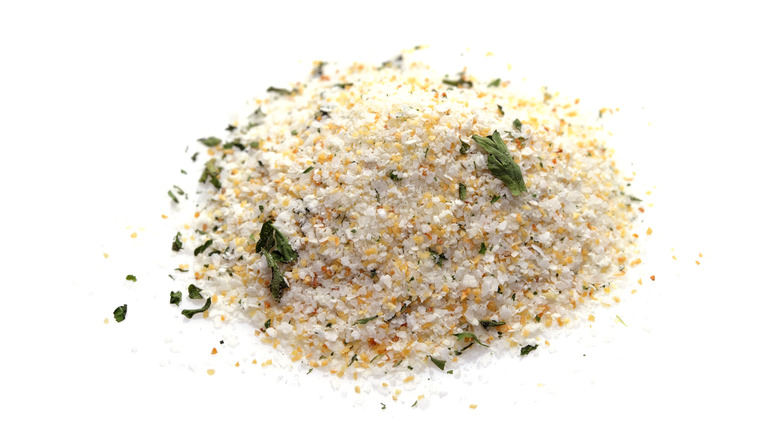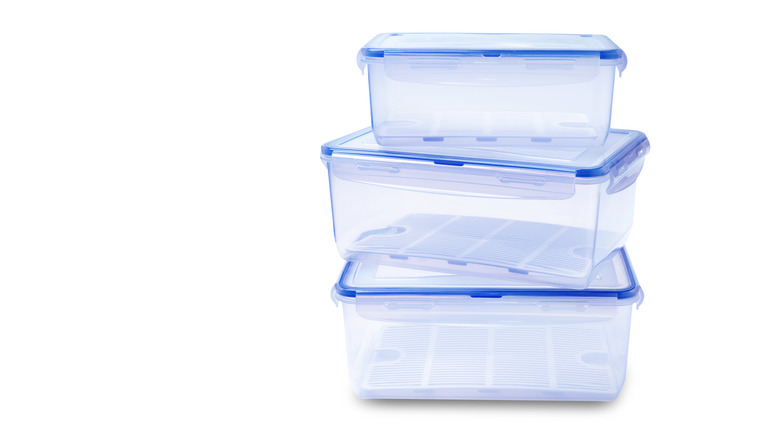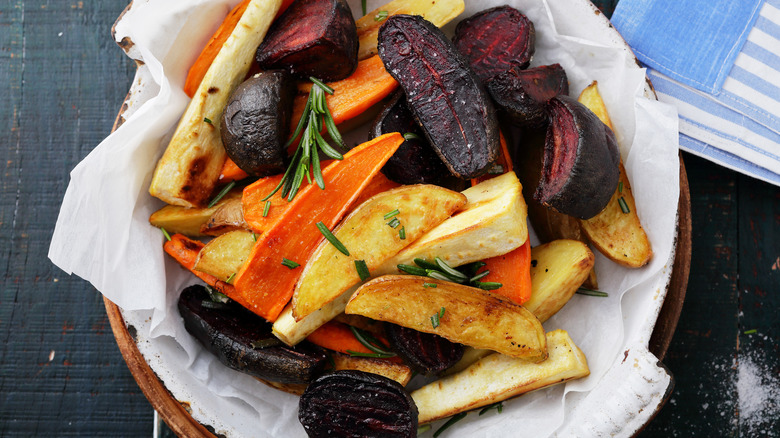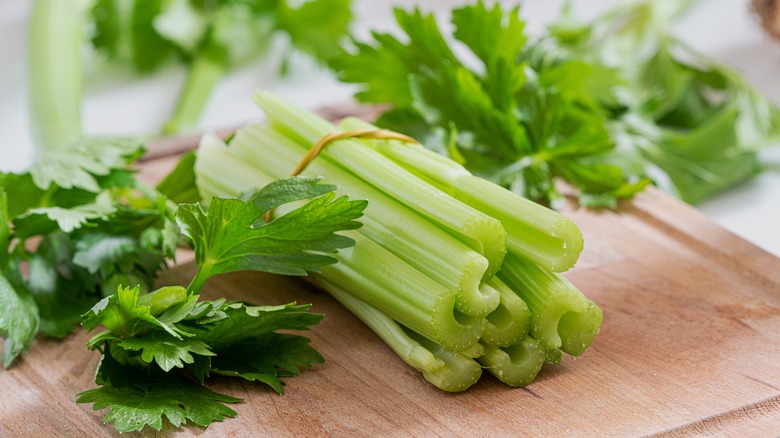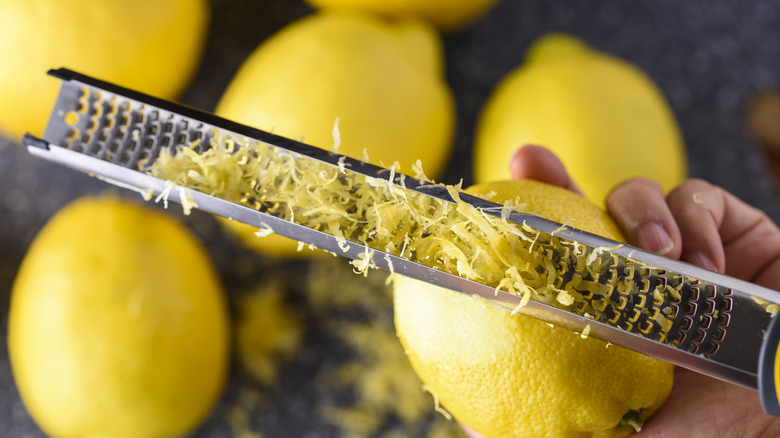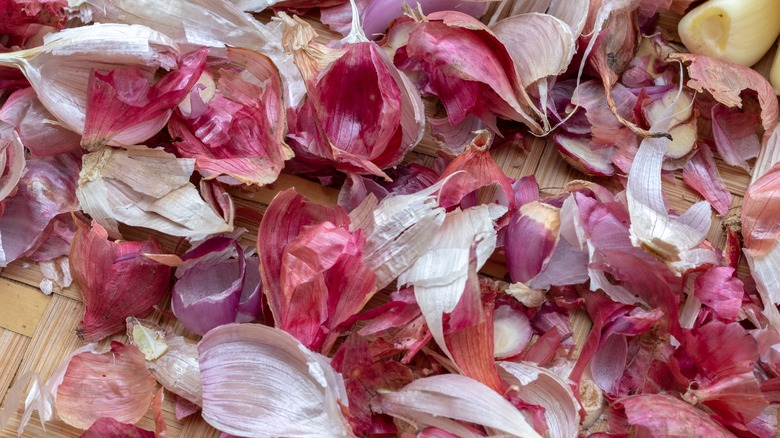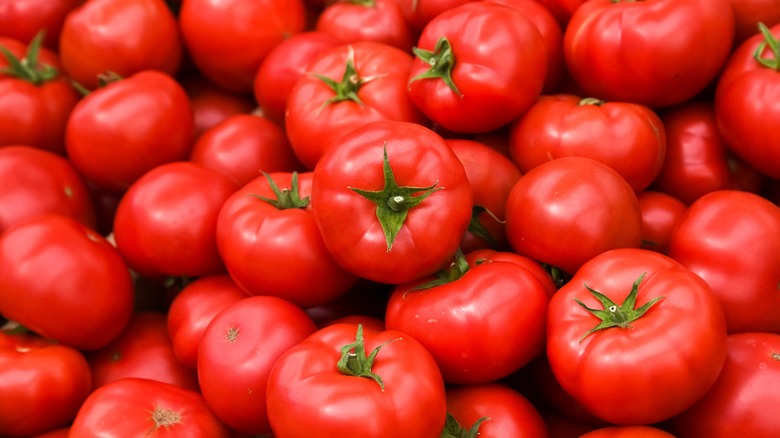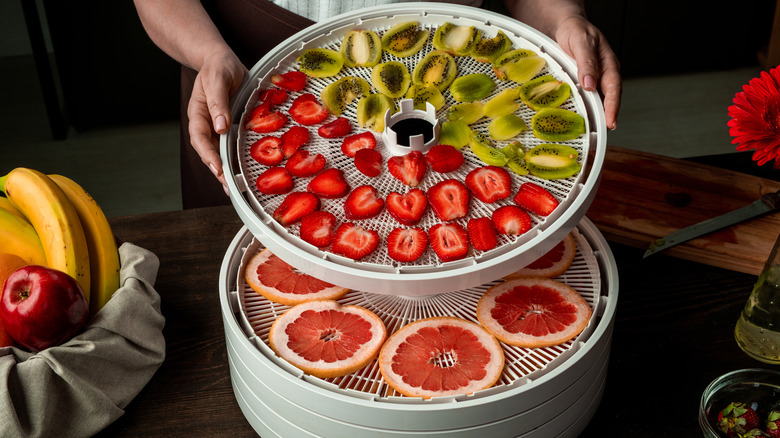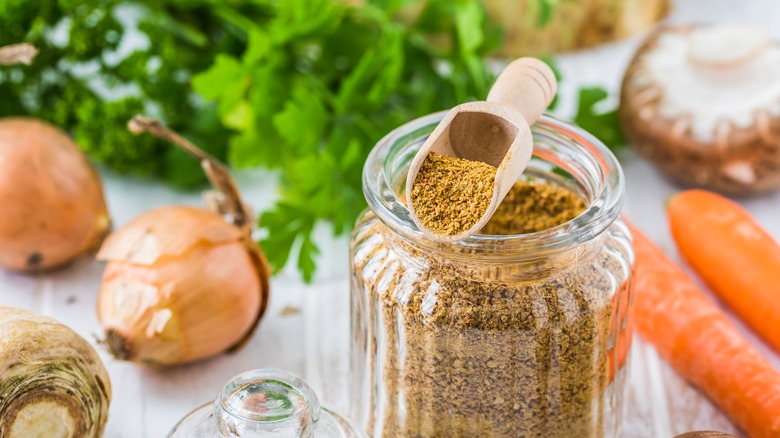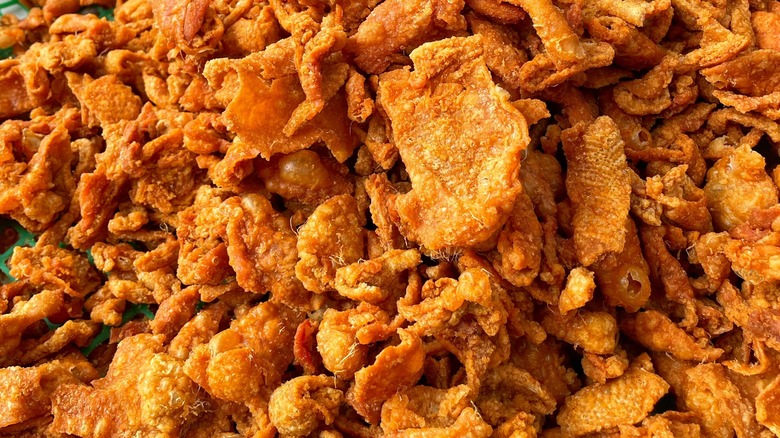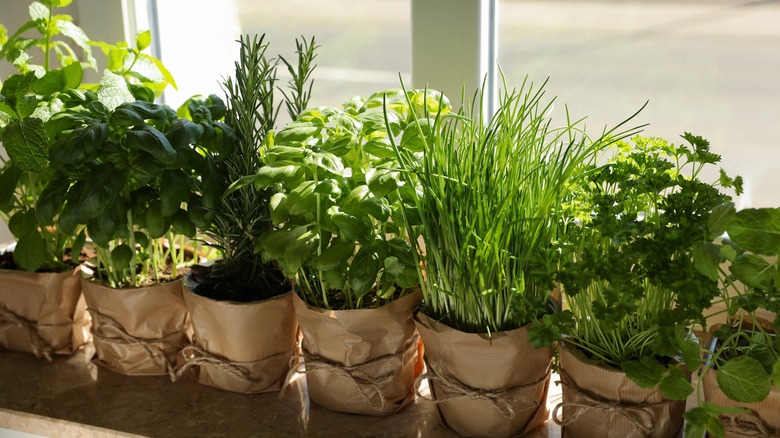10 Ways To Transform Cooking Scraps Into Robust Seasoning Salts
With the costs of food at record new levels and still ascending, it's become not just nice but necessary for cooks of all kinds to adopt ideas of top-to-tail cooking at home. Not just good for the wallet and good for the planet, this kind of thinking is the backbone of some of the most flavorful cuisines around the globe.
Top-to-tail cooking doesn't just involve meat, it applies to produce, too. It may help to think of it as a game: the objective is to pack every possible punch of flavor into every morsel of food. The best part of the game is everybody wins.
This is where the impact of seasoning salts comes into play. Wander down any herb and spice aisle in any North American grocery store, and you'll likely pass a variety of salts, from onion to garlic to celery. Each of these varieties is as easy to make at home as it is economical and delicious. Plus, garlic, onion, and celery are just the top of the salt-laden iceberg. Consider this inspiration on how to turn just about everything, from carrot peels to chicken skins, into your next favorite seasoning salt.
Keep scraps in the freezer until you have enough
While one lone garlic skin may seem insignificant, regular garlic users will know how quickly you can dice, roast, or mince your way through a whole head in no time. It pays to keep a ziplock bag, Tupperware, or other ice box-friendly container in your freezer, adding skins from garlic and onions, carrot and sweet potato peels, or whatever else would go into the compost bin or down the disposal after each meal you cook. Think of it as saving flavor for the future and cutting down on food waste.
If you regularly cook at home, especially if you're cooking for a few others before you know it, you'll have a bag filled with materials for your next creative cooking endeavor. Whether those scraps get turned into a soup, a stock, a seasoning salt, or all three is up to you and your household. Depending on what you plan to do and what dietary preferences or restrictions you need to consider, saving any meat-related scraps should be stashed in a separate bag.
Don't throw away the peels
Whether it's a big bowl of mashed potatoes, carrot and ginger soup, or honey-roasted beets, root vegetables have unbelievable flavor and nutrients to offer. And while the bulk of recipes rely on what's hidden beneath the surface, the peels are nothing to scoff at.
Next time root vegetables appear on your menu, consider making plans for their skins. First, you'll want to ensure they're properly scrubbed, especially if using non-organic produce. Then, while you're zoning out in your prep work, reserve the peels of your beetroot, celery root, or parsnip. Once fully dehydrated in the oven, dehydrator, or air frier, they can then be ground and mixed with a good flakey salt. That's all there is to it.
Sprinkle at will, using the flavors to amply and compliment whatever you're cooking next. Mashed potatoes with a dusting of celery root salt will add an earthy note. Carrot salt over chicken will add sweetness and will look pretty, too. Feel free to mix and match flavors, adding ginger, garlic, or herbs.
Save your discarded celery leaves, too
Generally speaking, many of us have been susceptible to having purchased at least one jar of celery salt, with good intentions of using it regularly but ultimately, relegating it to the back of the spice cupboard to collect dust. Celery salt is a major component of a good Blood Mary, but it can be a struggle knowing what else to do with it. The first thing to do to improve your relationship with the slightly enigmatic spice is to make it yourself with would-be discarded celery leaves.
Whether you're making your kids ants on a log, garnishing said bloody Mary, or digging into autumn with a seasonal vegetable soup, save the leaves on your next head of celery. Wash and pat dry the leaves before dehydrating them on a baking sheet in a 350 F oven — this won't take very long, so watch to ensure they don't burn.
Then simply crumble and combine with an equal amount of sea salt, sprinkle onto deviled eggs, macaroni or potato salad, or wherever you please. Back of the spice cupboard, no more for this homemade seasoning salt!
Don't let those citrus peels go to waste
If you've ever enjoyed a lemon twist in your martini or inhaled the scent of freshly zested lime, you'll be well aware of the concentrated, uplifting flavor and aroma contained in the peel of any citrus fruit. So why would you throw it away when it could be put to good use in so many ways? Peels can be mixed with salt in a variety of ways.
For those searching for instant gratification, make your very own jar of citrus-infused seasoning salt, which can be added to just about any savory dish that would benefit from salt and acid. After you've used the juice of however many lemons you need, zest the peels, tip into a mortar or food processor, and add the equivalent number of tablespoons of sea salt as lemons used for zesting. Then crush or blitz until well mixed and fragrant, and pour the salt into a jar or other seal-tight container. Add liberally to roasted or poached chicken, fish, steamed vegetables, or anything else that would benefit from the flavor.
For those looking for a slower process, try making your own jar of preserved lemons, a staple ingredient originally from North Africa, used in various cuisines and dishes from tagine to salad dressing. Like any fermenting or curing process, this isn't a quick-fix dish; rather, it benefits from one of the most potent ingredients there is: time.
Make full use of onions and garlic by using the skins
For anyone who has ever been frustrated by the quality of the onion or garlic salt, this one is for you. Rather than wasting your energy on disappointment or your money on a sub-par ingredient, save those onion and garlic skins and make your own. Reserve the skins of one onion and one head of garlic, then get to work.
First, you'll want to rehydrate the skins by soaking them in cold water for around ten minutes before patting them dry. Then, fully dehydrate them in a low oven at about 150 F for a gentle flavor, or crank it up to 410 F to add an element of smokiness. Low and slow will take around 3 hours, whereas fast and furious will be toasted and ready within 30 minutes.
Once the skins are fully dehydrated, crush or blend them into a powder and combine with sea salt at one part garlic and onion skins to five parts salt. You can also add crushed black pepper into the mix if desired. Store in an airtight container out of direct sunlight, like any other spice.
To amply the flavor, why not add an infused oil? You can recreate your own version of the fancy grocery store kind for pennies with a head-worth of garlic skins, ¾ cup of oil, and about 10 minutes of simmering before removing the skins and reserving the oil.
Skins from unsuspecting fruits like tomatoes work
Are you looking for the best finishing salt for a warm bowl of creamy tomato soup? Look no further than tomato salt. Made from the unused skins of the blanched tomatoes, this quintessential waste-free cooking tip should not be overlooked. Tomatoes are bursting with naturally produced MSG, which is why their savory-sweet flavor can be so satisfying, especially when paired with other foods like Parmesan, which are also high in glutamates.
To make this mouth-watering seasoning salt, you'll need equal parts coarse sea salt to tomato skins – weighting the skins out post-blanching is the easiest way to know just how much you're working with. Then, you'll want to coat the skins in an equal weight of salt before thoroughly drying them out via a baking tray in the oven at 200 F. When they look like they'd crumble as easily as a freshly fallen autumn leaf under your boot, they're ready to use. Grind the two ingredients together however you prefer, sprinkle liberally over everything, including a juicy tomato salad, and slide into tomato-scented heaven.
Put your dehydrator, air fryer, or oven to work
No matter the content of your kitchen scrap bowl or Tupperware, dehydration is the name of the game when creating a seasoning salt. As many home cooks discover the hard way by sprinkling herbs or spices directly from the container over a hot dish, moisture leads to clumping. Therefore, it becomes imperative to remove any access water stored in the stalks, skins, or peels before mixing with salt.
There are a few ways to achieve the desired level of dehydration, based on what tools you can access at home. The clue is in the name of the first tool that comes to mind: a dehydrator. Once a fad-worthy appliance used for making all kinds of snacks, from homemade jerky to apple chips, anyone who has devoted precious counter space to the dehydrator is probably looking for any good excuse to use it. Check the type of dehydrator you have for further instructions on how to use it.
Owners of the much-beloved air frier can also use it for dehydrating herbs, fruits, and other produce. To do so, use the lowest setting or the dehydrator setting if available. If using to dry out herbs, ensure they are weighted down (possibly with other seasoning salt ingredients) so they don't fly everywhere. Lastly, the oven or the toaster oven, at a low setting, is always a great option. And most kitchens will have one, even when short on other gadgets and appliances.
Try making vegetable bouillon
If you've got a mix of peels, stalks, and skins that need to be used up, why not throw them all together to make your own vegetable bouillon powder? It's the perfect catch-all seasoning for soups, stews and risottos. Not only does making it yourself reduce waste and stretch your food budget a bit further, but it also works to eliminate unnecessary ingredients like palm oil that can end up in some store-bought cubes.
Add whatever cooking scraps need using up, from broccoli stalks to herbs to carrot peels, into the blender and blitz until relatively smooth and uniform. Tip into a bowl and add salt, using a ratio of one portion of salt to five portions of vegetable paste for balance. Mix through, then spread out onto a lined baking sheet to dry out in a 300 F oven or into a dehydrator if you have one. Once the mixture has thoroughly dried out (time will depend on what ingredients are used), run it through the food processor again and store it in an airtight container. Use it to season a dish or replace boxed vegetable stock.
Give Australia's much-loved chicken salt a try
Chicken salt is, arguably, one of the most overlooked salts on this list. And while those in the know might want to keep this unbelievably delicious little secret all to themselves (and we wouldn't blame you), it's just too good not to mention. Sorry, Australia (and the U.K.), the secret needs to come out.
Chicken salt is packed with umami flavors. Made from a combination of dehydrated chicken skin, mushroom powder, salt, garlic, and onion powders, this delightful seasoning packs a punch and will have you salivating in seconds. Used as a dry rub for the chicken itself, chicken salt can also be sprinkled over popcorn, French fries, corn on the cob, vegetables, or anything else calling out for an extra burst of tongue-pleasing umami flavors.
To make your own chicken salt at home, reserve and roast however many chicken skins you have in a 350 F oven until brown, then strain fat (you can reserve this for cooking) and continue to reduce and render skin by simmering it in chicken stock. This process helps to intensify the chicken flavors, an essential quality for this seasoning. Next, reduce and dehydrate the stock-infused skins in a low oven or a dehydrator until the skins are dry and crispy. Toss them into a food processor along with salt, pepper, mushroom, garlic, and onion powder and blitz. Sprinkle liberally onto anything and everything.
Get creative with blends by adding herbs
As many regional climates begin to turn cooler, harvesting the remains of the herb garden before winter sets in might be on your 'to-do' list. Making a seasoning salt ( and a batch of pesto, chimichurri, and other herb-scented sauces and pastes) is a great way to use up some of your harvest.
Depending on the available herbs, you may need to air dry or air-fryer them to remove any excess moisture before mixing with sea salt. Herbs like rosemary, thyme, and dill tend to be on the drier side and may not need much additional time. Others like parsley, cilantro, and basil will benefit from being dried out before blending with sea salt or kosher to prevent clumping or melting.
Consider making a few herbal seasoning salt blends as a holiday or hostess gift or a goodwill gesture to a neighbor, teacher, grandparent, or avid home cook. There is something special about a homemade gift, no matter how simply made, especially one so delicious!
